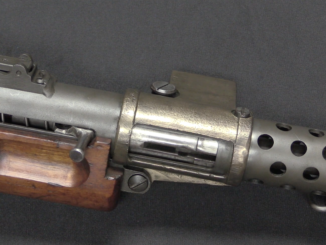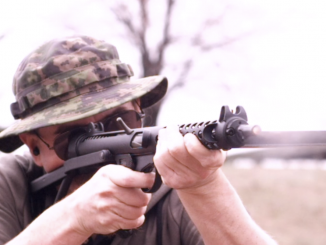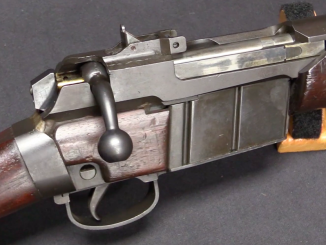RIA’s catalog page for this rifle
When the British military adopted the FAL (L1A1 SLR) in 1960, they adopted the 7.62x51mm NATO cartridge along with it. While the Brens guns were converted to the new cartridge, efforts at converting the Lee Enfield into a precision rifle were not successful t the time. However, civilian target shooters and the British NRA would work on perfecting that conversion for use in competition, and would ultimately produce very accurate 7.62mm rifles built on Lee Enfield actions – accurate enough that the military took notice. Copying the competition rifles, the British military would adopt the L42A1 in 1970, an Enfield action converted to 7.62mm NATO with a shortened and free-floated stock and hand guard and a heavy profile barrel. A total of 1,080 L42A1 rifles would be converted from existing No4 MkI(T) sniper rifles, and they would serve in the front lines of the British military until 1992, when they were replaced by the Accuracy International L96A1.




There was also a semi-commercial version intended for use as a police sharpshooters’ rifle, called the Enfield Enforcer.
The major difference between it and the L42 was that the Enforcer version often had the stock painted dark green or gray as “urban camouflage”. This led to a belief that it had a synthetic stock like the later AI L96.
But underneath, it was still the old traditional Canadian birch.
cheers
eon
Going from the pink medullary rays, I think that the woodwork is beech.
Enfield produced a commercial version of the enforcer called the Envoy, the leaf site was replaced with Parker-hale half or quarter minute iron sights. Parker-Hale themselves produced the T4, very passable target rifle on the No4 action and their own heavy match barrel.
Nice rifle and also a nice try from the Brits, but they are really just amateurs when it comes to recycling obsolescent 19th century actions. Only six years before this rifle was retired in 1991, Finnish Army introduced the 7.62 TKIV 85 (precision rifle 85 is the literal translation) based on the Mosin-Nagant action and recycled receivers (among other parts), some of which were manufactured before WW1. The L42A1 is also a lightweight contestant compared to the TKIV 85, which weighs 7 kg (15.4 lbs) with the bipod but WITHOUT a telescopic sight.
The TKIV 85 is still used today and the Finnish Army has no plans on replacing it any time soon, although slowly they have purchased more Sako TRG-42s. If I had to guess, the TKIV 85 will still be around in 2030.
I suppose that if the basic concept isn’t broken, fixing it will not work. Alternatively, one has to be sure that the system isn’t broken if something else does not go according to plan. Otherwise you get the results of Qing Dynasty Chinese Warlord Armies against the British Royal Navy: For the British, a complete turkey shoot, as the Chinese commanders assumed that the Westerners would just stand around to get skewered.
As for the issue of recycling designs, I assumed that the Mauser M98 style receiver and bolt was still being used as the basis for many a sniper rifle…
The TKIV 85 may not be broken, but it surely is obsolescent. It was an outdated concept back in 1985, but it was cheaper for the Army to recycle old Mosin-Nagant parts already in inventory than to order a modern sniper rifle. The rifles were assembled by Army gunsmiths and armorers as depot work, and they also made the stocks. According to the accounting rules of the day the labor of the Army personnel was “free”, because they were on a monthly salary anyways, so officially the cost of the rifles was only the new parts (such as barrels and trigger mechanisms, and of course the sights) and materials.
This begs the question: didn’t the army maintenance personnel have anything better to do with their time? It appears that they didn’t in the mid-1980s. All the WW2 leftover small arms were already checked and overhauled, or marked for sale or disposal. Maintaining the newer guns was not very time-consuming. So assembling the TKIV 85 was also a kind of a job program for skilled gunsmiths who were already intimately familiar with the Mosin-Nagant action.
Anally retentive quibble:
“Begging the question” actually refers to a circular argument where the question itself is used as part of the answer.
For example, “circular arguments are bad, because they are not very good”.
“This raises the question….”
All oils that confission.
Auto incorrect strikes again
“This raises the question…”
Avoids all of that confusion
Thanks for correcting my idioms! Wikipedia¹ says that in vernacular usage “begging the question” often means the same as “raising the question”, but technically that is incorrect.
¹ Not that I trust Wikipedia explicitly, but that statement seems to match my own experiences.
Recursive redundancy is a common grammatical error like saying off of as a preposition or calling an original as a version (Japanese version of Voltron when in fact Voltron is an English dub of two unrelated shows).
“TKIV 85, which weighs 7 kg (15.4 lbs) with the bipod but WITHOUT a telescopic sight.”
In Russia also stockpiled Pattern 1891/30 rifles were used as parts source for new sniper rifles, namely OTs-48 and OTs-48K, first photo from top shows OTs-48, rest shows OTs-48K: http://www.hpbt.org/articles/ots.htm
First retains classic layout and is much lighter than TKIV 85 at 5,4 kg including scope. OTs-48K is bull-pup variant and therefore curiously it belongs to rare group of bolt-action repeating bull-pup rifle and also rare group of stripper-fed bull-pup rifles (as OTs-48K retains feed system of donor).
I don’t actually know how they managed to make TKIV 85 so heavy. The barrel is of course very heavy for a rifle and the telescopic sight mount and bipod are not light, either. The wooden stock is also quite robust,but still the rifle appears to be overbuilt to a fault.
In general Finnish small arms have pretty much always been on the heavy side, starting from the L-S M/26 LMG and the Lahti L-35 pistol. The Rk 62 is also heavier than most AK variants thanks to the tubular steel stock, milled receiver and general heavy duty construction.
I have a No. 4 MkI/II FTR that I love, but my Remington Eddystone P14 will shoot rings around it. Why didn’t GB go with the P14 for sniping?
It’s no mystery to me why the British retained their .303 caliber sniper rifles for a decade. Sorry to Monday Morning quarterback this fine video presentation, but there are multiple components to a sniping system and ammunition is often overlooked. The United States adopted the 7.62mm NATO cartridge in 1954 even though the US Army didn’t adopt the M14 Rifle until 1957. The M14 featured an integral scope mounting point similar to the M1D sniper rifle. Early 7.62mm NATO ammunition wasn’t competitive in high power rifle matches when pitted against Caliber .30 M72 Match ammo and it wasn’t until 1963 that the M118 Match ammo for 7.62mm NATO was adopted after years of development.
http://www.snipercentral.com/history-m118-ammunition/
What did the sniper do for ammunition before the development of more-accurate (more consistent) match-grade ammunition–ammo that was often loaded with specialty bullets? Two sources say that the rifleman would test fire samples from different lots and then squirrel away a supply of the most accurate ammunition lot.
Herbert McBride mentioned selecting accurate lots of ammunition in his “A Rifleman Went to War,” and McBride’s First World War sniping experience in the Canadian Army (McBride was a US citizen) formed one of the primers for the modern Marine Corps sniper program under then-Captain Edward James Land, Jr.
Another mention of selecting high-quality service ammunition for sniping use is in John George’s “Shots Fired in Anger,” his account of fighting on Guadalcanal and Burma as a US Army intelligence officer.
It’s not a mystery to me. Britain just didn’t have time to develop match-grade ammunition for sniping when they adopted the 7.62mm NATO L1-series rifle in 1960. For top-drawer performance, all components of a sniper program must be top-drawer: tactics and doctrine, skilled riflemen with excellent field-craft, accurate rifle, top-notch optical sight on a stable scope mount (yes, most sniping was done with iron sights in the past–and the same requirement applies to electronic sights today: Starlight and thermal imaging), and match grade ammunition.
Interesting background, thank you.
Given that snipers will generally be supplied with separate ammunition stocks I’ve never really understood why there was such pressure to ‘standardise’ them onto the service cartridge dimensions. You’re going to have to set-up a separate manufacturing process and stock item for the match ammo, so why worry about it being 7.62×51? Just pick the best cartridge for the job.
“why worry about it being 7.62×51”
When using 7.62×51 it is possible to use others ammunition, which even if giving somewhat bigger spread, is better option than having without any ammunition at all in dire need.
A small thing from your video: The ejector screw was replaced, by a hardened lug soldered onto the magazine feedlips of the RSAF Enfield 7.62 mag.
Indian SMLEs converted to NATO held 12 rounds rather than 10. Which made them ‘assault rifles’ according to California law. I don’t know how long that held true, but its an example of how tricky writing laws can be…
That only applies if the rifle is a self-loading weapon, right? How can an assault rifle work if the action is not self-actuating? You may as well say that a rifle MINUS THE ENTIRE RECEIVER is an assault rifle if the barrel and ludicrously large magazine are present…
Well, under Bill Clinton after the AWB was passed, then-Deputy Attorney General Eric Holder (Later The One’s AG and architect of Operation Fast & Furious) tried to use the AWB magazine capacity limitations to ban .22 rifles, lever action rifles, and etc. that held 11 or more rounds in their fixed, internal tubular magazines, irrespective of whether they were “automatic” or not. As he openly said, “we’re going to use this law to capture entirely new categories of weapons”.
He was finally slapped down- hard- by the U.S. Supreme Court. In the process, becoming only the second U.S. AG ever held in contempt by same. (The other was John Mitchell of Watergate fame.)
The two morals of this are;
1. When someone on their own version of a Holy Crusade tells you, “We only want to do (fill in the blank)”, they are generally lying.
2. If a law can be twisted to do something it was supposedly not intended to do, it’s a safe bet that (a) it will be so twisted and (b) those who wrote it were anticipating doing exactly that when they wrote it.
cheers
eon
The last use of the Lee-Enfield action was actually the Number 8 rifle in
0.22 which was in service until recently
Hmmm, Canadian rangers have (supposedly)just giveneed up the Lee
Does the Indian Army still have SMLEs in emergency storage? Even if they don’t, I am fairly sure police in India still uses them, both in 7.62mm NATO and .410 single shot conversion.
Interestingly, .303 mk vii had approximately 50% greater effective range than .30-03 .30-06 or .30-06 m2 ball.
I’ve never done the calcs for the British version of 7.62×51 Nato, but bear in mind that. 303 mkvii. Is within half a minute of the “flat shooting” .270 winchester 130gr out to 300 yards, on bullet drop.
The early attempts at a 7.6mm conversion were seriously broken as sniper rifles .303 was never broken.
.
‘Skennerton’ has written on the conversion of the L42 for use by the Royal Marines in/after the Gulf War in the mid 2000’s. The picture I saw had the same scope as fitted to the Accuracy International using a new mount on the L42. Apparently the Accuracy International failed in the harsh desert conditions? A recent Italian Naval ship visit to Australia revealed that they still use SMLE N 1 Mk 3* rifles in the ships guard.
So yes the Schmidt & Bender L13a1 PM6x42 & L42a1 as a combination was evaluated by the RM/SBS, however Skennerton’s version whereby it extended the effective servicelife of that platform, by a decade or so, is exaggerated & has largely been debunked.
There is a book coming out later this year (called, the British Sniper:a Century of Evolution), which among other things, will adress this misnomer.
My potted sniper rifle history is that while there were efforts dating back to and before the Colonial Rebellion of 1776 (kidding, I’m British), it really began in 1915.
1915-45 all efforts focussed on using the service rifle as a sniper rifle. Post 1945, that continued – L42, M21 etc.
Only the Russians brought out a dedicated sniper rifle design, the SVD. Of course, the West would see that as a DMR or marksman or sharpshooter rifle, not a proper sniper rifle. Ironically, its use in Iraq and Afghanistan prompted the response of the (US) M14 DMR, and various AR10 variants like the SR25 and LMT L129 (UK). Maybe the Soviets had been on to a good idea in 1963?
US development from the 50s shifted to accurized versions of deer rifles – Winchester 70 and Remmy 700 (M40).
By the 80s, US development (McMillan) was on really good rifles loosely based on deer rifles. Euro was on a mix of the same (Steyr SSG) and weapons inspired by the failure of the Munich hostage rescue raid (PSG1).
The modern sniper rifle was revolutionised (I confess to being pretty ignorant about the Finnish rifle mentioned above) when Malcolm Cooper, a distinguished Olympic champion shooter, designed a sniper rifle from first principles in the late 80s or very early 90s. The AW.
Since then, setting aside 50BMG, the big things have been advances in suppressors, and the general move away from 7.62 to .338LM or similarito gain greater range.
Finally, we appear in the West to have a situation where there are dedicated weapons, with appropriate training standards, for close, medium, far, and very far. Each with different ammunition.
I expect the next move is to rationalise that down to two weapons. Close/medium a 6-6.5mm or re-invention of the late 40s British .280/30” in selective fire, and medium/long/MMG role in something like 338LM.